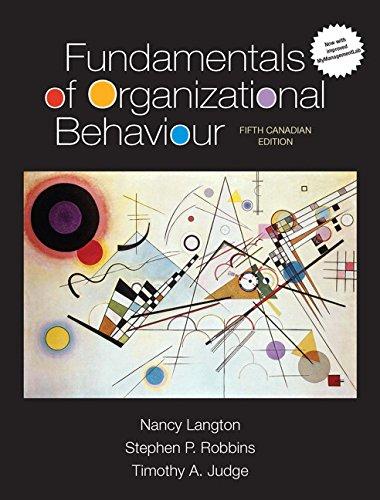A researcher doing a case study on emotions in organizations interviewed Laura, a 22-year-old customer-service representative in
Question:
A researcher doing a case study on emotions in organizations interviewed Laura, a 22-year-old customer-service representative in Australia. The following is a summary of the interview (with some paraphrasing of the interviewer questions):
INTERVIEWER: How would you describe your workplace?
LAURA: Very cold, unproductive, [a] very, umm, cold environment, atmosphere.
INTERVIEWER: What kinds of emotions are prevalent in your organization?
LAURA: Anger, hatred toward other people, other staff members.
INTERVIEWER: So, it seems that managers keep employees in line using fear tactics?
LAURA: Yeah. The General Manager's favorite saying is, "Nobody's indispensable." So, it's like, "I can't do that because I'll get sacked!"
INTERVIEWER: How do you survive in this situation?
LAURA: You have to cater your emotions to the sort of situation, the specific situation because it's just such a hostile environment, this is sort of the only way you can survive.
INTERVIEWER: Are there emotions you have to hide?
LAURA: Managers don't like you to show your emotions. They don't like to show that there is anything wrong or anything emotional in the working environment.
INTERVIEWER: Why do you go along?
LAURA: I feel I have to put on an act because to show your true emotions, especially toward my managers [Laura names two of her senior managers it would be hatred sometimes. So, you just can't afford to do that because it's your job and you need the money.
INTERVIEWER: Do you ever rebel against this system?
LAURA: You sort of put on a happy face just so you can annoy the managers. I find that they don't like people being happy, so you just annoy them by being happy. So, yeah. It just makes you laugh. You just "put it on" just because you know it annoys [management]. It's pretty vindictive and manipulative but you just need to do that.
INTERVIEWER: Do you ever find that this gets to you?
LAURA: I did care in the beginning, and I think it just got me into more trouble. So now I just tell myself, "I don't care." If you tell yourself something for long enough, eventually you believe it. Yeah, so now I just go "Oh well."
INTERVIEWER: Do you intend to keep working here?
LAURA: It's a means to an end now. So, every time I go to work and every week I just go, "Well, one week down, one week less until I go away." But if I knew that I didn't have this goal, I don't know if I could handle it, or if I would even be there now.
INTERVIEWER: Is there an upside to working here?
LAURA: I'm so much better at telling people off now than I ever used to be. I can put people in place in about three sentences. Like, instead of, before I would walk away from it. But now I just stand there and fight. I don't know if that's a good thing or a bad thing.
1. Do you think Laura is justified in her responses to her organization’s culture? Why or why not?
2. Do you think Laura’s strategic use and display of emotions serve to protect her?
3. Assuming that Laura’s description is accurate, how would you react to the organization’s culture?
4. Research shows that acts of co-workers (37 percent) and management (22 percent) cause more negative emotions for employees than do acts of customers 7 percent. What can Laura’s company do to change its emotional climate?
Step by Step Answer:

Fundamentals Of Organizational Behaviour
ISBN: 9780134204932
5th Canadian Edition
Authors: Nancy Langton, Stephen Robbins, Timothy Judge





